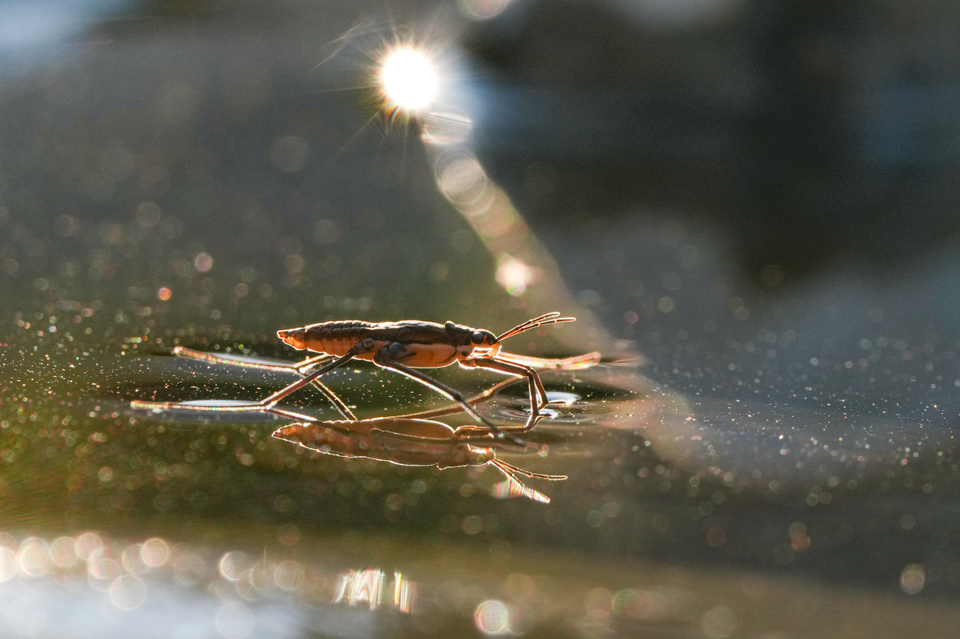Superaquatic Film Skaters

Drop a feather on a pond and you'll observe one of water's most astonishing properties—its ability to form a stretchy, elastic membrane (or film) that holds objects on its surface.

For animals living on and around water, this stable membrane can be either a barrier or an opportunity, but water striders are one of the few animals that are superbly adapted for living in this unique environment. Neither aquatic, nor terrestrial, water striders are known as superaquatic organisms because they spend their entire lives in this threshold world between air and water.

You can find water striders on almost any type of pond, puddle, marsh, or river (and some species even live on the open ocean!). At times they are abundant and occur in groups, with late summer being the best time to find them because lower water levels concentrate them in smaller pockets of open water.

Water striders effectively use water surfaces because their legs are superhydrophobic, which means it is almost impossible to get them wet. In fact, water strider legs are so buoyant they can support 15 times the insect's weight without sinking. And this super buoyancy allows water striders to skate across water at speeds of several hundred body lengths per second (equivalent to a human swimming 400 miles per hour!).

Like tiny rowboats, water striders move by rowing around in search of any insects (either alive or dead) that fall on the water's surface. Striders hold their front legs up in preparation for quickly grabbing prey, while their middle legs do all the rowing, and their hind legs do all the steering.

Living on water surfaces also means that a water strider's world is shaped by touch and vibration. Not only do they detect the subtle vibrations of struggling prey, but water striders bounce their legs on water surfaces to drum out complex messages to each other.

For example, a male might find a suitable mating site, then create a high frequency vibration to attract females. And if a female is ready, she can reply with a low frequency vibration as she approaches for mating.

While mating, a male will then send out warning ripples if other males approach and try to interrupt their mating. And in one peculiar twist, if a male grabs onto an unwilling female he may create ripples that attract fish, forcing the female to cooperate or risk getting eaten because she's under him.

At the same time female choice matters because females are well protected from unwanted mating attempts and can even dislodge males if they want to. However, over 99% of the females at a given location may be mating at any one moment and it seems like there's a simple reason for this. Females that are mating and being guarded by males will be protected from the repeated advances of amorous satellite males, which allows her to focus on finding food rather than spending all her time defending herself. (And females that don't want to mate will sit quietly on the shoreline to avoid all this chaos.)

One other unique feature (among many!) of water striders is that they exhibit wing polymorphism, which is a fancy way of saying they switch between three different wing types. Some individuals have no wings, some have small nonfunctional wings, and others have normal wings, and they can switch between wing types in different habitats or at different times of the year. Wings allow water striders to fly several miles in search of new patches of water, but wings are also costly to produce—and sometimes a water strider needs to save its energy for mating.
Next time you see a pool of water with water striders milling around, I hope you take a moment to appreciate that there is a lot going on as they call to each other; try to figure out each other's sexes; initiate courtship, mating, and egg laying; guard mates; set up territories; create space around their territories; and track down food using a complex range of vibrations and signals.

Member discussion